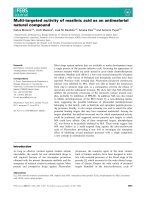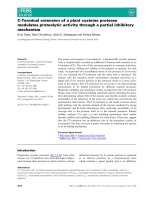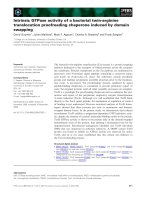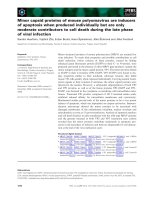Báo cáo khoa học: "Simple semi-supervised training of part-of-speech taggers" pptx
Bạn đang xem bản rút gọn của tài liệu. Xem và tải ngay bản đầy đủ của tài liệu tại đây (100.14 KB, 4 trang )
Proceedings of the ACL 2010 Conference Short Papers, pages 205–208,
Uppsala, Sweden, 11-16 July 2010.
c
2010 Association for Computational Linguistics
Simple semi-supervised training of part-of-speech taggers
Anders Søgaard
Center for Language Technology
University of Copenhagen
Abstract
Most attempts to train part-of-speech tag-
gers on a mixture of labeled and unlabeled
data have failed. In this work stacked
learning is used to reduce tagging to a
classification task. This simplifies semi-
supervised training considerably. Our
prefered semi-supervised method com-
bines tri-training (Li and Zhou, 2005) and
disagreement-based co-training. On the
Wall Street Journal, we obtain an error re-
duction of 4.2% with SVMTool (Gimenez
and Marquez, 2004).
1 Introduction
Semi-supervised part-of-speech (POS) tagging is
relatively rare, and the main reason seems to be
that results have mostly been negative. Meri-
aldo (1994), in a now famous negative result, at-
tempted to improve HMM POS tagging by expec-
tation maximization with unlabeled data. Clark
et al. (2003) reported positive results with little
labeled training data but negative results when
the amount of labeled training data increased; the
same seems to be the case in Wang et al. (2007)
who use co-training of two diverse POS taggers.
Huang et al. (2009) present positive results for
self-training a simple bigram POS tagger, but re-
sults are considerably below state-of-the-art.
Recently researchers have explored alternative
methods. Suzuki and Isozaki (2008) introduce
a semi-supervised extension of conditional ran-
dom fields that combines supervised and unsuper-
vised probability models by so-called MDF pa-
rameter estimation, which reduces error on Wall
Street Journal (WSJ) standard splits by about 7%
relative to their supervised baseline. Spoustova
et al. (2009) use a new pool of unlabeled data
tagged by an ensemble of state-of-the-art taggers
in every training step of an averaged perceptron
POS tagger with 4–5% error reduction. Finally,
Søgaard (2009) stacks a POS tagger on an un-
supervised clustering algorithm trained on large
amounts of unlabeled data with mixed results.
This work combines a new semi-supervised
learning method to POS tagging, namely tri-
training (Li and Zhou, 2005), with stacking on un-
supervised clustering. It is shown that this method
can be used to improve a state-of-the-art POS tag-
ger, SVMTool (Gimenez and Marquez, 2004). Fi-
nally, we introduce a variant of tri-training called
tri-training with disagreement, which seems to
perform equally well, but which imports much less
unlabeled data and is therefore more efficient.
2 Tagging as classification
This section describes our dataset and our input
tagger. We also describe how stacking is used to
reduce POS tagging to a classification task. Fi-
nally, we introduce the supervised learning algo-
rithms used in our experiments.
2.1 Data
We use the POS-tagged WSJ from the Penn Tree-
bank Release 3 (Marcus et al., 1993) with the
standard split: Sect. 0–18 is used for training,
Sect. 19–21 for development, and Sect. 22–24 for
testing. Since we need to train our classifiers on
material distinct from the training material for our
input POS tagger, we save Sect. 19 for training our
classifiers. Finally, we use the (untagged) Brown
corpus as our unlabeled data. The number of to-
kens we use for training, developing and testing
the classifiers, and the amount of unlabeled data
available to it, are thus:
tokens
train 44,472
development 103,686
test 129,281
unlabeled 1,170,811
205
The amount of unlabeled data available to our
classifiers is thus a bit more than 25 times the
amount of labeled data.
2.2 Input tagger
In our experiments we use SVMTool (Gimenez
and Marquez, 2004) with model type 4 run incre-
mentally in both directions. SVMTool has an ac-
curacy of 97.15% on WSJ Sect. 22-24 with this
parameter setting. Gimenez and Marquez (2004)
report that SVMTool has an accuracy of 97.16%
with an optimized parameter setting.
2.3 Classifier input
The way classifiers are constructed in our experi-
ments is very simple. We train SVMTool and an
unsupervised tagger, Unsupos (Biemann, 2006),
on our training sections and apply them to the de-
velopment, test and unlabeled sections. The re-
sults are combined in tables that will be the input
of our classifiers. Here is an excerpt:
1
Gold standard SVMTool Unsupos
DT DT 17
NNP NNP 27
NNP NNS 17*
NNP NNP 17
VBD VBD 26
Each row represents a word and lists the gold
standard POS tag, the predicted POS tag and the
word cluster selected by Unsupos. For example,
the first word is labeled ’DT’, which SVMTool
correctly predicts, and it belongs to cluster 17 of
about 500 word clusters. The first column is blank
in the table for the unlabeled section.
Generally, the idea is that a classifier will learn
to trust SVMTool in some cases, but that it may
also learn that if SVMTool predicts a certain tag
for some word cluster the correct label is another
tag. This way of combining taggers into a single
end classifier can be seen as a form of stacking
(Wolpert, 1992). It has the advantage that it re-
duces POS tagging to a classification task. This
may simplify semi-supervised learning consider-
ably.
2.4 Learning algorithms
We assume some knowledge of supervised learn-
ing algorithms. Most of our experiments are im-
plementations of wrapper methods that call off-
1
The numbers provided by Unsupos refer to clusters; ”*”
marks out-of-vocabulary words.
the-shelf implementations of supervised learning
algorithms. Specifically we have experimented
with support vector machines (SVMs), decision
trees, bagging and random forests. Tri-training,
explained below, is a semi-supervised learning
method which requires large amounts of data.
Consequently, we only used very fast learning al-
gorithms in the context of tri-training. On the de-
velopment section, decisions trees performed bet-
ter than bagging and random forests. The de-
cision tree algorithm is the C4.5 algorithm first
introduced in Quinlan (1993). We used SVMs
with polynomial kernels of degree 2 to provide a
stronger stacking-only baseline.
3 Tri-training
This section first presents the tri-training algo-
rithm originally proposed by Li and Zhou (2005)
and then considers a novel variant: tri-training
with disagreement.
Let L denote the labeled data and U the unla-
beled data. Assume that three classifiers c
1
, c
2
, c
3
(same learning algorithm) have been trained on
three bootstrap samples of L. In tri-training, an
unlabeled datapoint in U is now labeled for a clas-
sifier, say c
1
, if the other two classifiers agree on
its label, i.e. c
2
and c
3
. Two classifiers inform
the third. If the two classifiers agree on a label-
ing, there is a good chance that they are right.
The algorithm stops when the classifiers no longer
change. The three classifiers are combined by ma-
jority voting. Li and Zhou (2005) show that un-
der certain conditions the increase in classification
noise rate is compensated by the amount of newly
labeled data points.
The most important condition is that the three
classifiers are diverse. If the three classifiers are
identical, tri-training degenerates to self-training.
Diversity is obtained in Li and Zhou (2005) by
training classifiers on bootstrap samples. In their
experiments, they consider classifiers based on the
C4.5 algorithm, BP neural networks and naive
Bayes classifiers. The algorithm is sketched
in a simplified form in Figure 1; see Li and
Zhou (2005) for all the details.
Tri-training has to the best of our knowledge not
been applied to POS tagging before, but it has been
applied to other NLP classification tasks, incl. Chi-
nese chunking (Chen et al., 2006) and question
classification (Nguyen et al., 2008).
206
1: for i ∈ {1 3} do
2: S
i
← bootstrap sample(L)
3: c
i
← train classifier (S
i
)
4: end for
5: repeat
6: for i ∈ {1 3} do
7: for x ∈ U do
8: L
i
← ∅
9: if c
j
(x) = c
k
(x)(j, k = i) then
10: L
i
← L
i
∪ {(x, c
j
(x)}
11: end if
12: end for
13: c
i
← train classifier (L ∪ L
i
)
14: end for
15: until none of c
i
changes
16: apply majority vote over c
i
Figure 1: Tri-training (Li and Zhou, 2005).
3.1 Tri-training with disagreement
We introduce a possible improvement of the tri-
training algorithm: If we change lines 9–10 in the
algorithm in Figure 1 with the lines:
if c
j
(x) = c
k
(x) = c
i
(x)(j, k = i) then
L
i
← L
i
∪ {(x, c
j
(x)}
end if
two classifiers, say c
1
and c
2
, only label a data-
point for the third classifier, c
3
, if c
1
and c
2
agree
on its label, but c
3
disagrees. The intuition is
that we only want to strengthen a classifier in its
weak points, and we want to avoid skewing our
labeled data by easy data points. Finally, since tri-
training with disagreement imports less unlabeled
data, it is much more efficient than tri-training. No
one has to the best of our knowledge applied tri-
training with disagreement to real-life classifica-
tion tasks before.
4 Results
Our results are presented in Figure 2. The stacking
result was obtained by training a SVM on top of
the predictions of SVMTool and the word clusters
of Unsupos. SVMs performed better than deci-
sion trees, bagging and random forests on our de-
velopment section, but improvements on test data
were modest. Tri-training refers to the original al-
gorithm sketched in Figure 1 with C4.5 as learn-
ing algorithm. Since tri-training degenerates to
self-training if the three classifiers are trained on
the same sample, we used our implementation of
tri-training to obtain self-training results and vali-
dated our results by a simpler implementation. We
varied poolsize to optimize self-training. Finally,
we list results for a technique called co-forests (Li
and Zhou, 2007), which is a recent alternative to
tri-training presented by the same authors, and for
tri-training with disagreement (tri-disagr). The p-
values are computed using 10,000 stratified shuf-
fles.
Tri-training and tri-training with disagreement
gave the best results. Note that since tri-training
leads to much better results than stacking alone,
it is unlabeled data that gives us most of the im-
provement, not the stacking itself. The differ-
ence between tri-training and self-training is near-
significant (p <0.0150). It seems that tri-training
with disagreement is a competitive technique in
terms of accuracy. The main advantage of tri-
training with disagreement compared to ordinary
tri-training, however, is that it is very efficient.
This is reflected by the average number of tokens
in L
i
over the three learners in the worst round of
learning:
av. tokens in L
i
tri-training 1,170,811
tri-disagr 173
Note also that self-training gave very good re-
sults. Self-training was, again, much slower than
tri-training with disagreement since we had to
train on a large pool of unlabeled data (but only
once). Of course this is not a standard self-training
set-up, but self-training informed by unsupervised
word clusters.
4.1 Follow-up experiments
SVMTool is one of the most accurate POS tag-
gers available. This means that the predictions
that are added to the labeled data are of very
high quality. To test if our semi-supervised learn-
ing methods were sensitive to the quality of the
input taggers we repeated the self-training and
tri-training experiments with a less competitive
POS tagger, namely the maximum entropy-based
POS tagger first described in (Ratnaparkhi, 1998)
that comes with the maximum entropy library in
(Zhang, 2004). Results are presented as the sec-
ond line in Figure 2. Note that error reduction is
much lower in this case.
207
BL stacking tri-tr. self-tr. co-forests tri-disagr error red. p-value
SVMTool 97.15% 97.19% 97.27% 97.26% 97.13% 97.27% 4.21% <0.0001
MaxEnt 96.31% - 96.36% 96.36% 96.28% 96.36% 1.36% <0.0001
Figure 2: Results on Wall Street Journal Sect. 22-24 with different semi-supervised methods.
5 Conclusion
This paper first shows how stacking can be used to
reduce POS tagging to a classification task. This
reduction seems to enable robust semi-supervised
learning. The technique was used to improve the
accuracy of a state-of-the-art POS tagger, namely
SVMTool. Four semi-supervised learning meth-
ods were tested, incl. self-training, tri-training, co-
forests and tri-training with disagreement. All
methods increased the accuracy of SVMTool sig-
nificantly. Error reduction on Wall Street Jour-
nal Sect. 22-24 was 4.2%, which is comparable
to related work in the literature, e.g. Suzuki and
Isozaki (2008) (7%) and Spoustova et al. (2009)
(4–5%).
References
Chris Biemann. 2006. Unsupervised part-of-speech
tagging employing efficient graph clustering. In
COLING-ACL Student Session, Sydney, Australia.
Wenliang Chen, Yujie Zhang, and Hitoshi Isahara.
2006. Chinese chunking with tri-training learn-
ing. In Computer processing of oriental languages,
pages 466–473. Springer, Berlin, Germany.
Stephen Clark, James Curran, and Mike Osborne.
2003. Bootstrapping POS taggers using unlabeled
data. In CONLL, Edmonton, Canada.
Jesus Gimenez and Lluis Marquez. 2004. SVMTool: a
general POS tagger generator based on support vec-
tor machines. In LREC, Lisbon, Portugal.
Zhongqiang Huang, Vladimir Eidelman, and Mary
Harper. 2009. Improving a simple bigram HMM
part-of-speech tagger by latent annotation and self-
training. In NAACL-HLT, Boulder, CO.
Ming Li and Zhi-Hua Zhou. 2005. Tri-training: ex-
ploiting unlabeled data using three classifiers. IEEE
Transactions on Knowledge and Data Engineering,
17(11):1529–1541.
Ming Li and Zhi-Hua Zhou. 2007. Improve computer-
aided diagnosis with machine learning techniques
using undiagnosed samples. IEEE Transactions on
Systems, Man and Cybernetics, 37(6):1088–1098.
Mitchell Marcus, Mary Marcinkiewicz, and Beatrice
Santorini. 1993. Building a large annotated cor-
pus of English: the Penn Treebank. Computational
Linguistics, 19(2):313–330.
Bernard Merialdo. 1994. Tagging English text with
a probabilistic model. Computational Linguistics,
20(2):155–171.
Tri Nguyen, Le Nguyen, and Akira Shimazu. 2008.
Using semi-supervised learning for question classi-
fication. Journal of Natural Language Processing,
15:3–21.
Ross Quinlan. 1993. Programs for machine learning.
Morgan Kaufmann.
Adwait Ratnaparkhi. 1998. Maximum entropy mod-
els for natural language ambiguity resolution. Ph.D.
thesis, University of Pennsylvania.
Anders Søgaard. 2009. Ensemble-based POS tagging
of italian. In IAAI-EVALITA, Reggio Emilia, Italy.
Drahomira Spoustova, Jan Hajic, Jan Raab, and
Miroslav Spousta. 2009. Semi-supervised training
for the averaged perceptron POS tagger. In EACL,
Athens, Greece.
Jun Suzuki and Hideki Isozaki. 2008. Semi-supervised
sequential labeling and segmentation using giga-
word scale unlabeled data. In ACL, pages 665–673,
Columbus, Ohio.
Wen Wang, Zhongqiang Huang, and Mary Harper.
2007. Semi-supervised learning for part-of-speech
tagging of Mandarin transcribed speech. In ICASSP,
Hawaii.
David Wolpert. 1992. Stacked generalization. Neural
Networks, 5:241–259.
Le Zhang. 2004. Maximum entropy modeling toolkit
for Python and C++. University of Edinburgh.
208









